 |
…the incredible story of how a group of inspired and eminent doctors flew down from USA to SSSIHMS, WF in February 2010 to perform a moving
miracle of mending hearts.
Mr. Y. Arvind
When I look back on what happened in the Cardiac Catheterization Lab at the Sri Sathya Sai Institute of Higher Medical Sciences (SSSIHMS), Whitefield, Bangalore in the second and third week of February 2010, I cannot but agree with the aphorism, “mysterious are the ways of the Lord”. They were miracles, yes, but not the kind that are beyond the ken of science, but real and tangible instances of incredible selflessness that rebuilt scores of lives amazingly.
 |
|
The team with Dr. Michael Rakoff and Dr. Voleti Choudary. Seated from left - Dr. Sai Leela Dhanekula, Dr. Roger Freedman, Mr. Ted Zaharias. Standing from left - Dr. Michael Rakoff (process consultant, SSSIHMS), Dr. Voleti Choudary (Chairman, Cardiac Sciences, SSSIHMS), Dr. Keshav Nayak, Dr. Sanjay Shah |
A team of doctors of international repute flew down from various parts of USA (Utah, Oklahoma, Illinois and California) and in a span of 14 days starting from February 8, they treated over 80 cardiac patients, virtually gifting them new lives with the help of most expensive medical devices they had brought along with them. The monetary value of free service offered was at least Rs. 45 Million.
What did they exactly do? And who are these ‘miracle-makers’?
The Modern Specialties in Cardiology
These doctors were eminent cardiologists specializing in interventional cardiology and electrophysiology. Puzzled? Here is what these sub branches of cardiology really deal with, in simple language.
Cardiologists are trained in the diagnosis and treatment of disorders of the heart. They hold the key to identifying abnormal conditions of the heart, the knowledge of which they pass on to the cardiac surgeons who operate on patients. In recent times, however, thanks to innovative thinking and technology, Cardiology has expanded from mere diagnosis to performing interventional procedures.
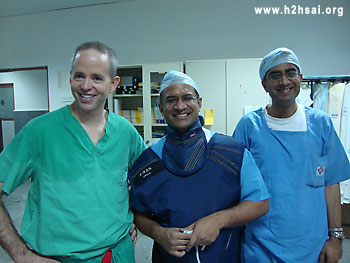 |
|
Dr. Collin Cowley, Dr. Keshav Nayak and Dr. Sanjay Shah |
The latter are like mini-surgeries done in the Cardiac Catheterization lab, giving to the patient almost the same benefit as a full-fledged bypass surgery without the scalpel and suture touching the heart.
While this is interventional cardiology, electro-physiology is another branch of Cardiology where doctors study and diagnose conditions when the heart begins to beat abnormally and treat this with the help of many modern devices and techniques.
The Work Done
With this background, here is what the doctors did in February 2010 in SSSIHMS, WF.
(The below two paragraphs contain certain technical terms which are unavoidable but anybody with a medical background will be able to appreciate the details)
Dr. Keshav Nayak, an adult interventional cardiologist, and Dr. Collin Cowley, a pediatric interventional cardiologist, implanted Atrial Septal Defect (ASD) closure devices, coarctation stents, Ventricular Septal Defect closure (VSD) devices, Patent Ductus Arteriosus (PDA) duct occluders, and performed balloon valvuloplasty for congenitally stenosed valves. And all these devices were brought by the group. This is happened from February 8th till 14th.
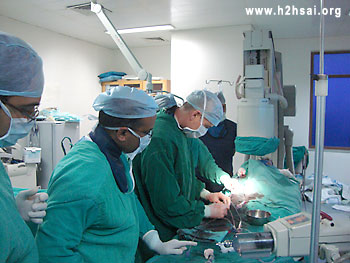 |
 |
|
Device closure in progress - Dr. Cowley and Dr. Nayak in action |
Dr. Freedman, Dr. Sai Leela and Ted configuring an ICD |
In the subsequent week, that is, from February 15th to 20th, three senior electro-physiologists, Dr. Roger Freedman, Dr. Sai Leela Dhanekula and Dr. Moeen Abedin implanted Automatic Implantable Cardiac Defibrillators (AICDs), Cardiac Resynchronization Therapy/Defibrillators (CRTDs), and pacemakers. Again, all these implants were carried from the USA by these doctors including a few pacemakers that were bought in India.
 |
The Indelible Impact
For the 80 odd patients who benefited from these procedures, this was beyond imagination. They could not have even dreamed of such an opportunity – and here it was in reality. All of them without exception came from economically weaker stratum of society.
Take for instance, Ravi, the son of a tourist taxi driver, who had a hole in his heart. His malady was solved without having to do an open heart surgery by just implanting a closure device that costs US $ 5000 (Rs. 2,50,000). Having received this treatment free, the father was speechless.
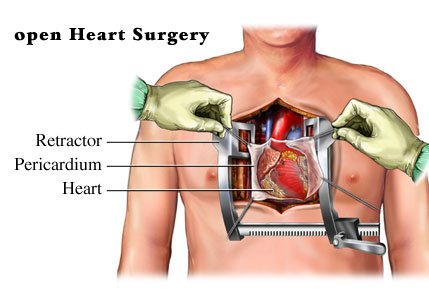 |
The boy not only did not have to spend a rupee but also was saved from an open heart surgery. Just to give an idea of what this means, this is what happens in an open heart operation, where the doctors will actually work on the heart.
Why is this Work so Special?
The sternum (or ribcage) is sawed open and then the heart is put on Cardio-Pulmonary Bypass (i.e. the blood from the heart is circulated by a machine called Heart Lung Machine through sterile tubing, in effect performing the job of the heart and lungs). The heart is then incised, surgery done and closed.
Then the bypass is stopped and once the heart begins to function, the sternum is closed by binding the split bone with titanium steel wire that remains inside the body for the rest of the patient’s life. And this is just the surgery part of it. After surgery, there is always the risk of post operative complications, secondary infections, undiagnosed allergies, bad lungs, wound healing, ICU trauma and so on.
At the end of all this, sadly, the patient is marked for life with a scar on the chest. The total stay of the patient in the hospital ranges from 4 to 10 days depending on the patient and the seriousness of the surgery. And the entire process from the diagnostics to surgery to post-op care to discharge costs anything from Rs. 2,00,000/- to Rs.3,00,000/- in India.
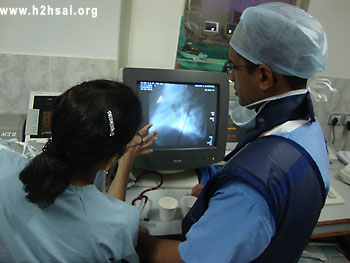 |
|
Electro-physiology meets interventional cardiology |
Compare this with a 30-50 minute procedure of a catheter going up the femoral vein or artery to the spot inside the heart where there is a hole, and the device being released at that point. Once this is done, the catheter is withdrawn, and the patient is discharged from the hospital in 24 hours from the time of admission!
That’s what device closure does for septal defects (holes in the heart). And it is not just Ravi who benefited from this procedure; there were another forty four such cases.
If this is a glimpse of what the eminent interventional cardiologists did, the work done by electro-physiologists was even more thrilling. These doctors implanted various sophisticated devices to monitor, correct and regulate the rhythm of the heart.
The Quality and Quantum of Selfless Service
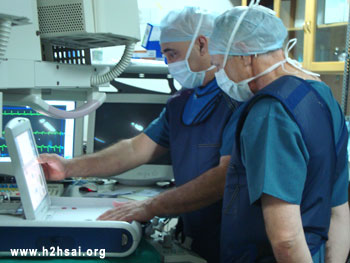 |
|
Ted and Dr. Freedman during an ICD implantation |
Each ICD (Implantable Cardioverter Defibrillators) set costs a minimum of Rs.5,00,000/-, and every CRTD (Cardiac Resynchronization Therapy/Defibrillators) is available for Rs.9,50,000/-.
And a set of pacemakers in India is about Rs.7,50,000/-. Imagine twenty five of these astronomically expensive devices being implanted in as many patients, totally free of charge!
In fact, according to a representative of St. Jude (a medical company that supplied the devices) for the entire year of 2008 the firm had done a total of 8 pacemaker implants in the entire state of Karnataka. In the year 2009 the number rose to 13.
But in SSSIHMS, WF the same number was done in one week! It is the same with ICD and CRTD implants which are in single digit every year elsewhere while a record number were done in that one week of February.
Golden Hearts Who Reflect God’s Love
And who has to be thanked for all this? The Lord, definitely. And also His wonderful instruments – the ‘miracle-makers’. If one goes by the respect these distinguished doctors command in the medical fraternity, it was truly a dream team. Dr. Roger Freedman, for example, is the Director of Clinical Cardiology and Professor of Medicine at the University of Utah Health Sciences Centre; Dr. Collin Cowley is Associate Director of Pediatric Cardiology and Associate Professor of Pediatrics at the University of Utah School of Medicine; Dr. Keshav Nayak is a commander in the US Navy and a Staff Interventional Cardiologist at the Naval Hospital in San Diego, California; Dr. Moeen Abedin is Assistant Professor of Medicine, Electrophysiology Section at the University of Oklahoma.
 |
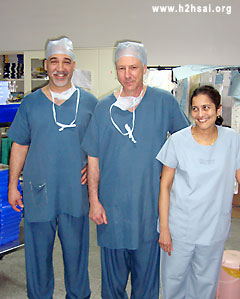 |
|
The electro physiology team - Mr. Ted Zaharias, Dr. Roger Freedman and Dr. Sai Leela Dhanekula |
There was also in the team Dr. Sai Leela Dhanekula, who was a student in the Anantapur Campus of Sri Sathya Sai University for a year and currently a practicing electro-physiologist. Another important member of the team was Mr. Ted Zaharias, a Territorial Sales Representative for St. Jude Medical, the company which along with W.L Gore and Amplatzer supplied all the devices and implants.
In fact, the long association of all these doctors with these three global medical companies ensured a direct channel for these devices to reach the needy patients in SSSIHMS. If the doctors facilitated their procurement, it was the largesse of these international firms to donate these phenomenally expensive devices. And this happened because they were impressed and convinced of the selfless work being done in SSSIHMS right from its inception.
This miracle of Love happened because there was a pure intention to begin with which was followed up with months of meticulous planning and fool-proof execution.
One member of the team who did this wonderfully was Dr. Sanjay Shah. A Cardiology Fellow at the University of Utah and a member of the prestigious medical honor society Alpha Omega Aplha, Dr. Shah coordinated the entire effort with great élan. The only verse that comes to my mind which could aptly summarise the feelings of the patients who benefited from this noble endeavour is “You Decorated My Life” by Kenny Rogers.
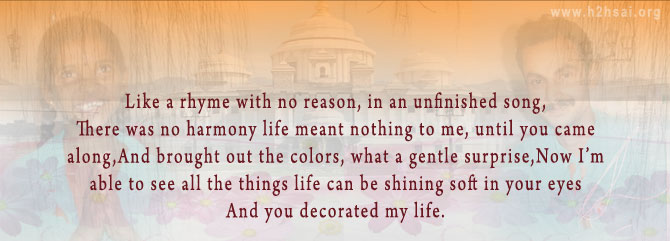 |
“Compassion is more important than money” - Baba
On the day of inauguration of SSSIHMS, WF, Bhagavan Baba had said,
“Compassion is more important than money. Some doctors wonder how we can treat patients free of charge. You can work wonders with purity of heart. Any work which is started with purity of heart is bound to succeed. Money flows if your work is suffused with love and sacrifice. People will volunteer with adequate funds to support any noble endeavour… This Hospital has a divine quality that will draw the whole world to it.” |
How true! What the hospital saw on February 2010 was a tiny glimpse of this glorious vision that the Lord has willed for this sacred home of healing!
For more information about these Hospitals, please visit www.sssmt.org.in
- Heart2Heart Team





